Detailed Business Plan: Marks & Spencer's Growth & Opportunities
VerifiedAdded on 2023/06/17
|13
|2759
|97
AI Summary
This document presents a business plan focused on Marks & Spencer (M&S), a British international retail company specializing in clothing, food, and home products. The plan details M&S's mission, vision, and values, emphasizing quality and innovation, particularly in plant-based food products to address health and wellness trends. It analyzes the industry using Porter's Five Forces, assessing the threat of new entrants, substitutes, customer and supplier bargaining power, and competitive rivalry, highlighting key competitors like Macy's, Next, and Debenhams. The plan outlines operations, including business processes, supply chain management, and a skilled management team. It also describes a marketing strategy based on the Four P's (Product, Price, Promotion, Place), emphasizing innovative products, competitive pricing, social media and television marketing, and online and direct sales distribution channels. Finally, it identifies potential funding sources, including equity shares and bank loans. Desklib provides a range of study tools and solved assignments for students.
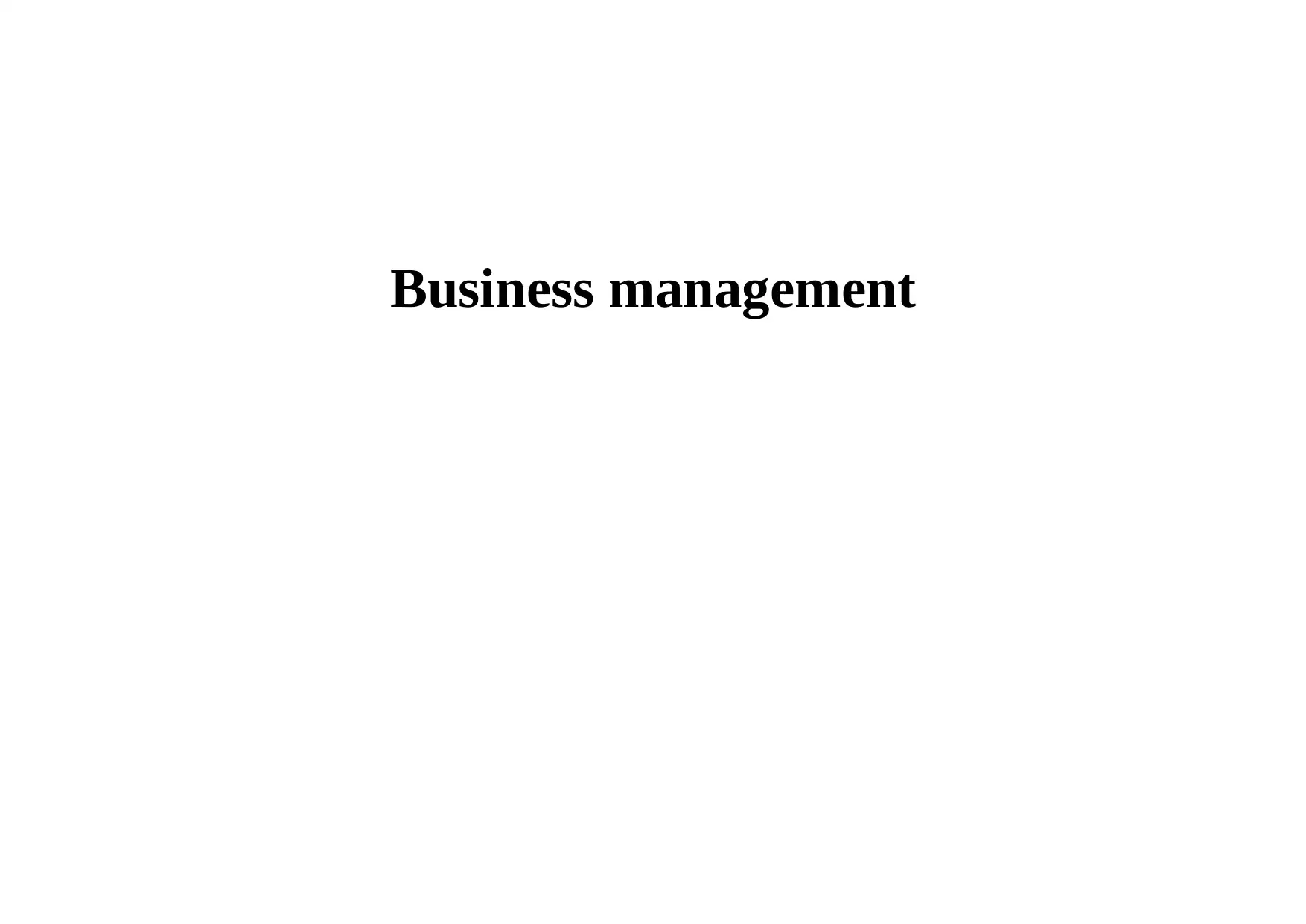
Business management
Paraphrase This Document
Need a fresh take? Get an instant paraphrase of this document with our AI Paraphraser
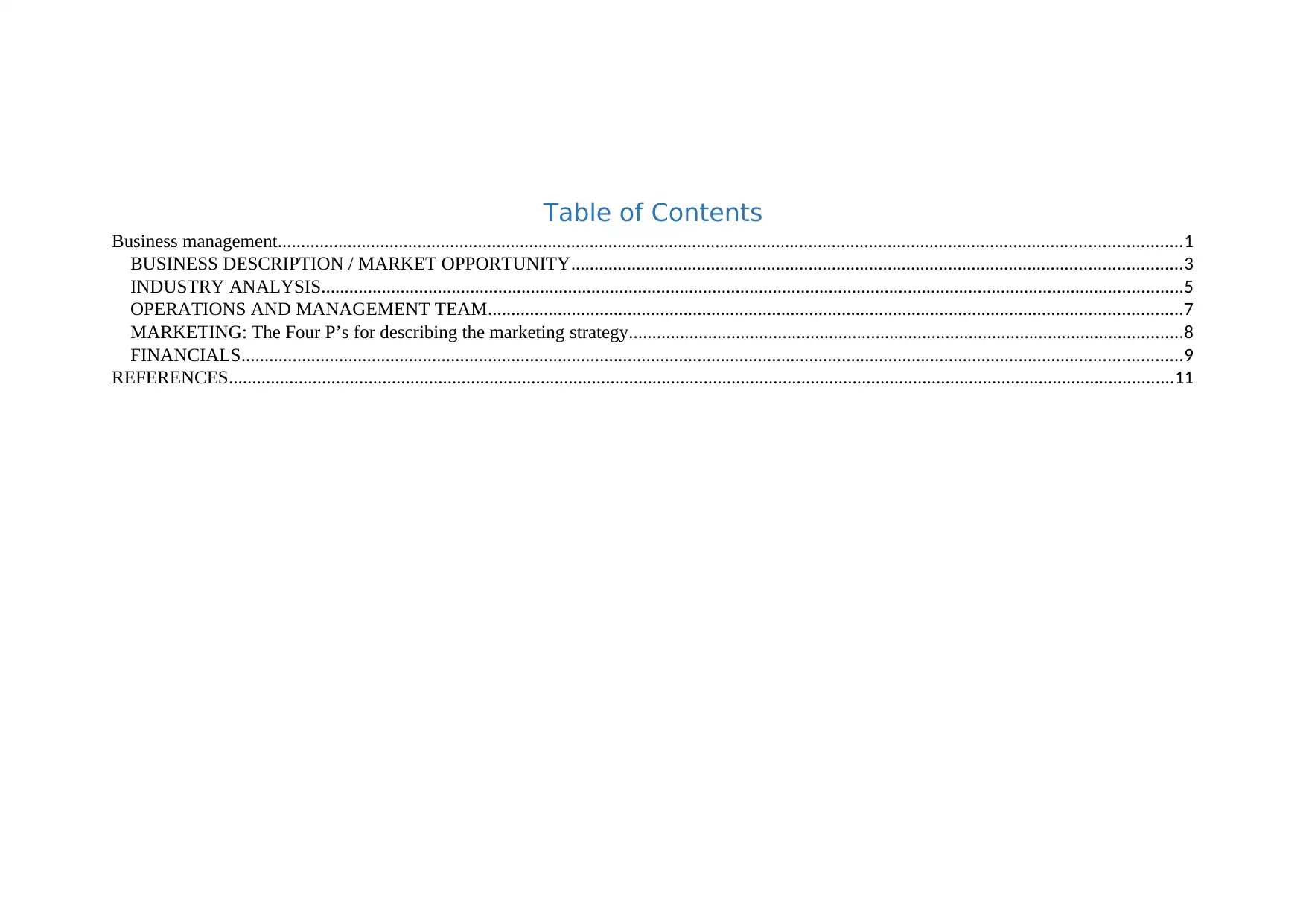
Table of Contents
Business management..................................................................................................................................................................................................1
BUSINESS DESCRIPTION / MARKET OPPORTUNITY...................................................................................................................................3
INDUSTRY ANALYSIS.........................................................................................................................................................................................5
OPERATIONS AND MANAGEMENT TEAM.....................................................................................................................................................7
MARKETING: The Four P’s for describing the marketing strategy.......................................................................................................................8
FINANCIALS..........................................................................................................................................................................................................9
REFERENCES...........................................................................................................................................................................................................11
Business management..................................................................................................................................................................................................1
BUSINESS DESCRIPTION / MARKET OPPORTUNITY...................................................................................................................................3
INDUSTRY ANALYSIS.........................................................................................................................................................................................5
OPERATIONS AND MANAGEMENT TEAM.....................................................................................................................................................7
MARKETING: The Four P’s for describing the marketing strategy.......................................................................................................................8
FINANCIALS..........................................................................................................................................................................................................9
REFERENCES...........................................................................................................................................................................................................11
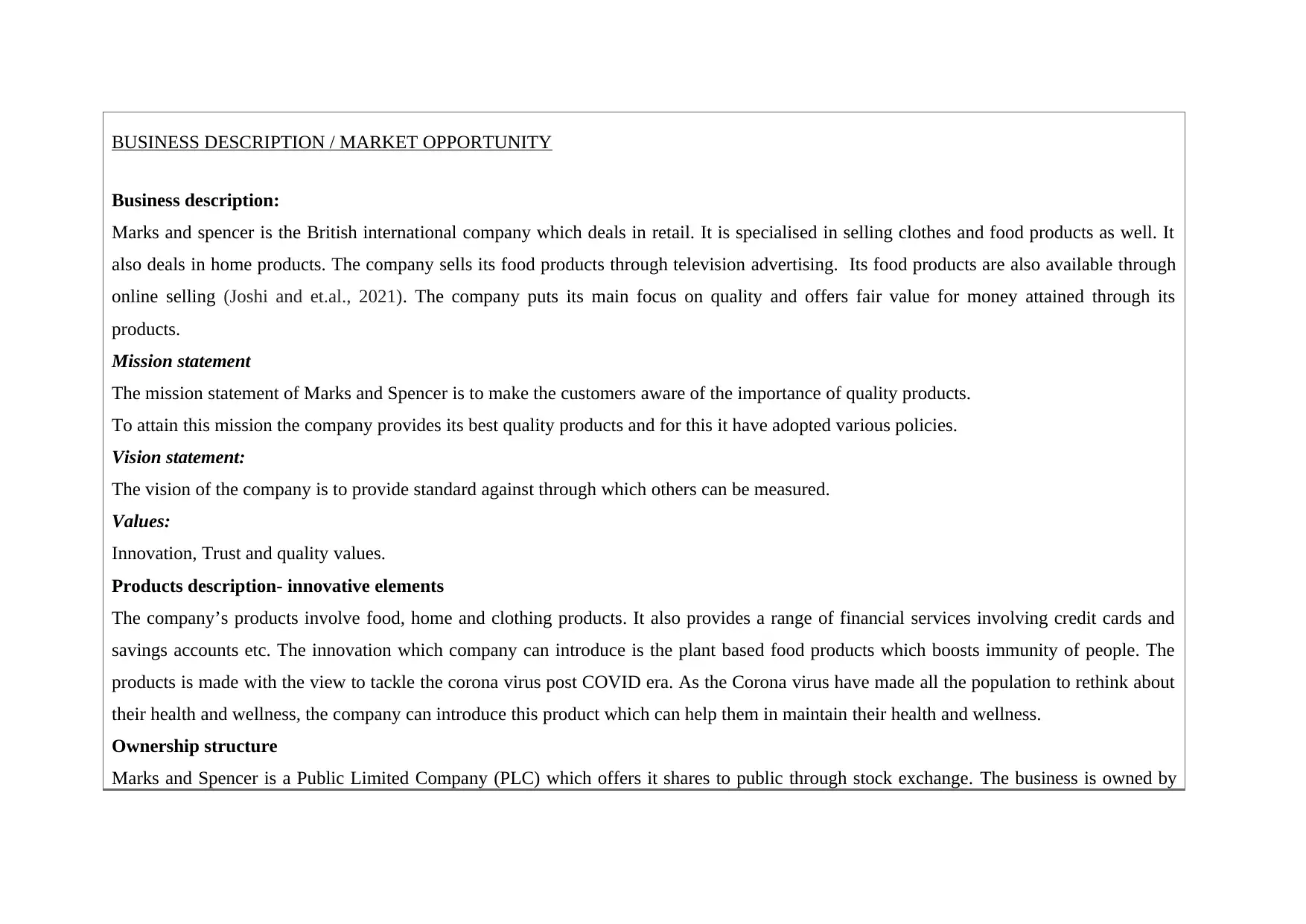
BUSINESS DESCRIPTION / MARKET OPPORTUNITY
Business description:
Marks and spencer is the British international company which deals in retail. It is specialised in selling clothes and food products as well. It
also deals in home products. The company sells its food products through television advertising. Its food products are also available through
online selling (Joshi and et.al., 2021). The company puts its main focus on quality and offers fair value for money attained through its
products.
Mission statement
The mission statement of Marks and Spencer is to make the customers aware of the importance of quality products.
To attain this mission the company provides its best quality products and for this it have adopted various policies.
Vision statement:
The vision of the company is to provide standard against through which others can be measured.
Values:
Innovation, Trust and quality values.
Products description- innovative elements
The company’s products involve food, home and clothing products. It also provides a range of financial services involving credit cards and
savings accounts etc. The innovation which company can introduce is the plant based food products which boosts immunity of people. The
products is made with the view to tackle the corona virus post COVID era. As the Corona virus have made all the population to rethink about
their health and wellness, the company can introduce this product which can help them in maintain their health and wellness.
Ownership structure
Marks and Spencer is a Public Limited Company (PLC) which offers it shares to public through stock exchange. The business is owned by
Business description:
Marks and spencer is the British international company which deals in retail. It is specialised in selling clothes and food products as well. It
also deals in home products. The company sells its food products through television advertising. Its food products are also available through
online selling (Joshi and et.al., 2021). The company puts its main focus on quality and offers fair value for money attained through its
products.
Mission statement
The mission statement of Marks and Spencer is to make the customers aware of the importance of quality products.
To attain this mission the company provides its best quality products and for this it have adopted various policies.
Vision statement:
The vision of the company is to provide standard against through which others can be measured.
Values:
Innovation, Trust and quality values.
Products description- innovative elements
The company’s products involve food, home and clothing products. It also provides a range of financial services involving credit cards and
savings accounts etc. The innovation which company can introduce is the plant based food products which boosts immunity of people. The
products is made with the view to tackle the corona virus post COVID era. As the Corona virus have made all the population to rethink about
their health and wellness, the company can introduce this product which can help them in maintain their health and wellness.
Ownership structure
Marks and Spencer is a Public Limited Company (PLC) which offers it shares to public through stock exchange. The business is owned by
⊘ This is a preview!⊘
Do you want full access?
Subscribe today to unlock all pages.

Trusted by 1+ million students worldwide
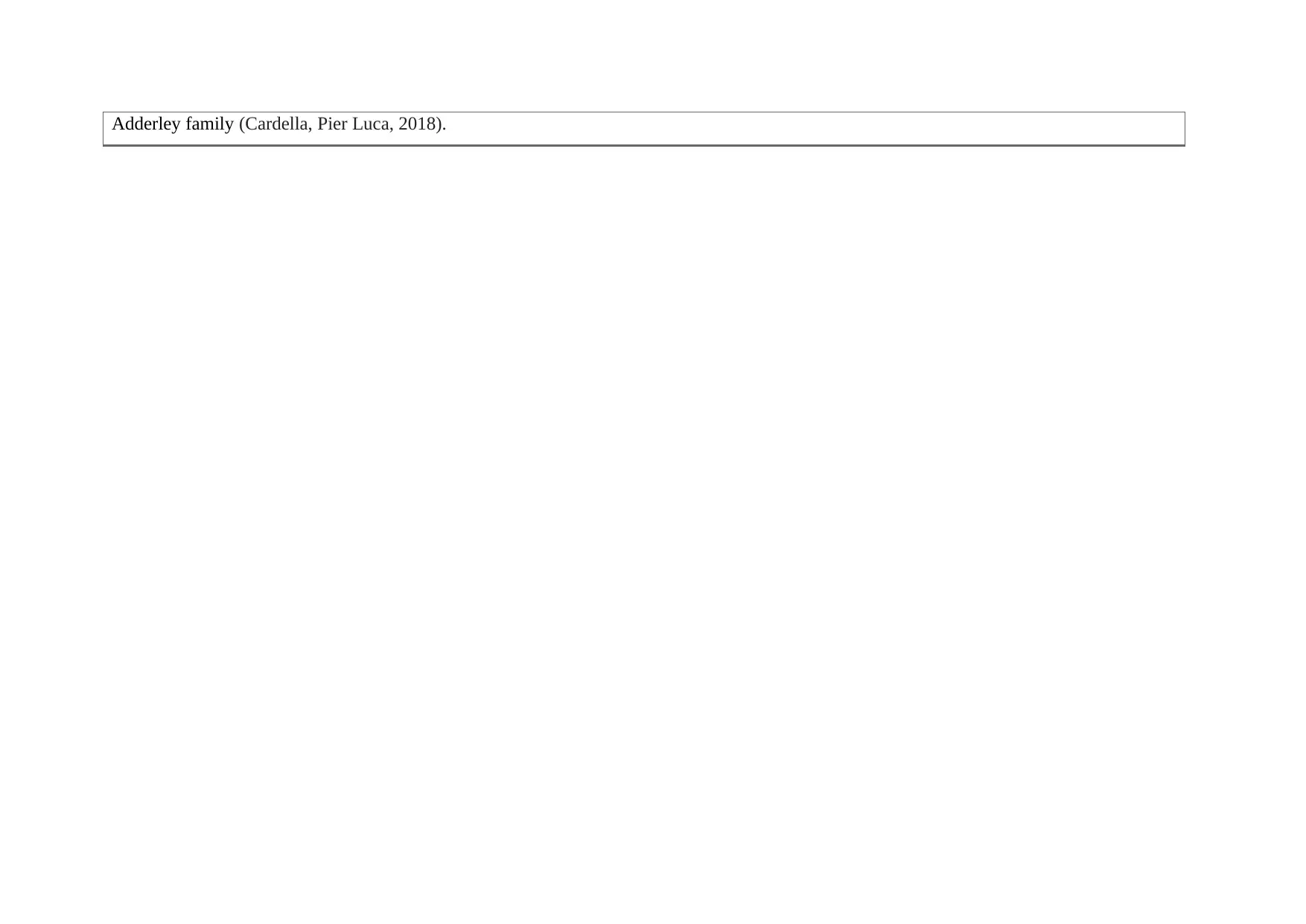
Adderley family (Cardella, Pier Luca, 2018).
Paraphrase This Document
Need a fresh take? Get an instant paraphrase of this document with our AI Paraphraser
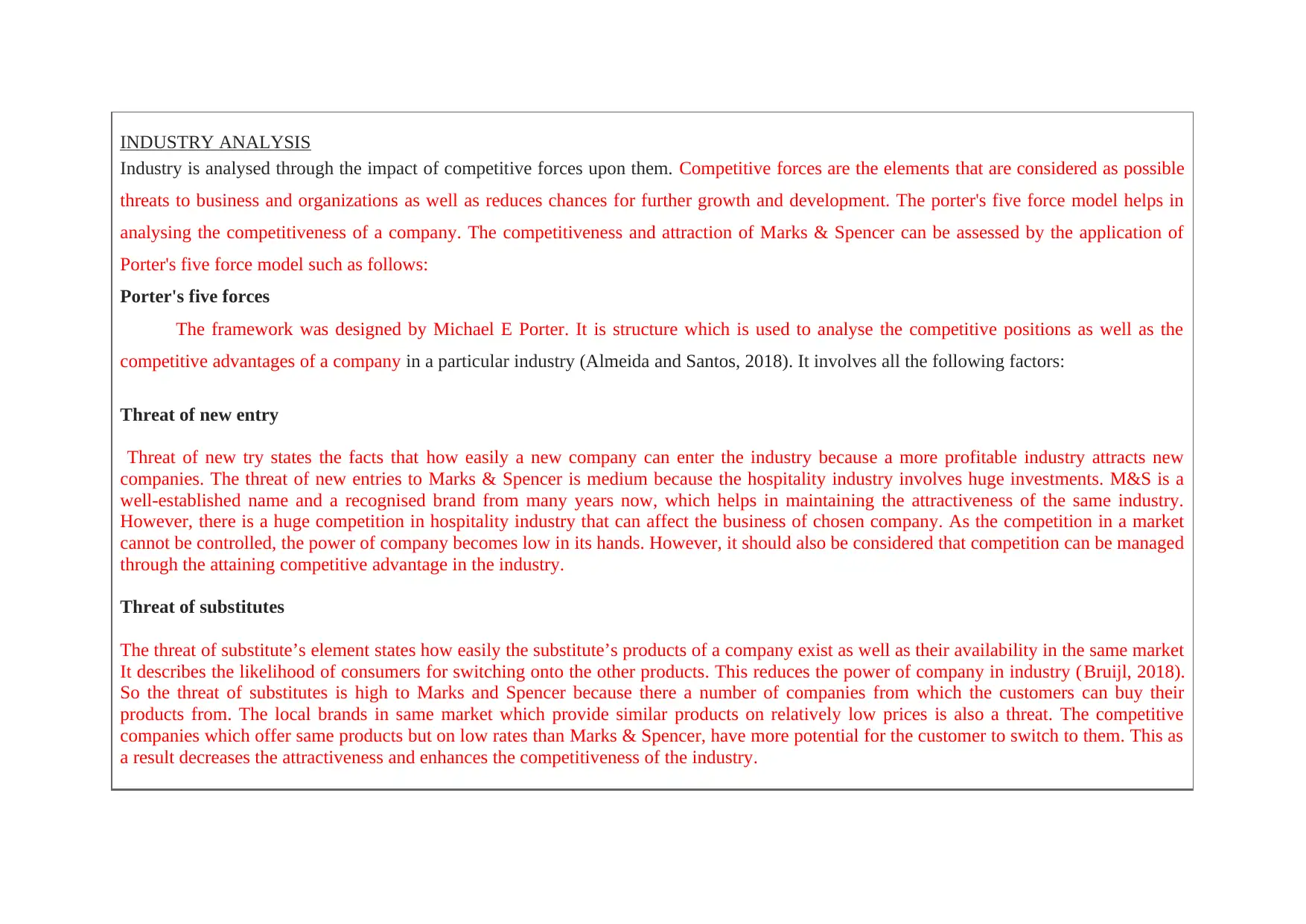
INDUSTRY ANALYSIS
Industry is analysed through the impact of competitive forces upon them. Competitive forces are the elements that are considered as possible
threats to business and organizations as well as reduces chances for further growth and development. The porter's five force model helps in
analysing the competitiveness of a company. The competitiveness and attraction of Marks & Spencer can be assessed by the application of
Porter's five force model such as follows:
Porter's five forces
The framework was designed by Michael E Porter. It is structure which is used to analyse the competitive positions as well as the
competitive advantages of a company in a particular industry (Almeida and Santos, 2018). It involves all the following factors:
Threat of new entry
Threat of new try states the facts that how easily a new company can enter the industry because a more profitable industry attracts new
companies. The threat of new entries to Marks & Spencer is medium because the hospitality industry involves huge investments. M&S is a
well-established name and a recognised brand from many years now, which helps in maintaining the attractiveness of the same industry.
However, there is a huge competition in hospitality industry that can affect the business of chosen company. As the competition in a market
cannot be controlled, the power of company becomes low in its hands. However, it should also be considered that competition can be managed
through the attaining competitive advantage in the industry.
Threat of substitutes
The threat of substitute’s element states how easily the substitute’s products of a company exist as well as their availability in the same market
It describes the likelihood of consumers for switching onto the other products. This reduces the power of company in industry (Bruijl, 2018).
So the threat of substitutes is high to Marks and Spencer because there a number of companies from which the customers can buy their
products from. The local brands in same market which provide similar products on relatively low prices is also a threat. The competitive
companies which offer same products but on low rates than Marks & Spencer, have more potential for the customer to switch to them. This as
a result decreases the attractiveness and enhances the competitiveness of the industry.
Industry is analysed through the impact of competitive forces upon them. Competitive forces are the elements that are considered as possible
threats to business and organizations as well as reduces chances for further growth and development. The porter's five force model helps in
analysing the competitiveness of a company. The competitiveness and attraction of Marks & Spencer can be assessed by the application of
Porter's five force model such as follows:
Porter's five forces
The framework was designed by Michael E Porter. It is structure which is used to analyse the competitive positions as well as the
competitive advantages of a company in a particular industry (Almeida and Santos, 2018). It involves all the following factors:
Threat of new entry
Threat of new try states the facts that how easily a new company can enter the industry because a more profitable industry attracts new
companies. The threat of new entries to Marks & Spencer is medium because the hospitality industry involves huge investments. M&S is a
well-established name and a recognised brand from many years now, which helps in maintaining the attractiveness of the same industry.
However, there is a huge competition in hospitality industry that can affect the business of chosen company. As the competition in a market
cannot be controlled, the power of company becomes low in its hands. However, it should also be considered that competition can be managed
through the attaining competitive advantage in the industry.
Threat of substitutes
The threat of substitute’s element states how easily the substitute’s products of a company exist as well as their availability in the same market
It describes the likelihood of consumers for switching onto the other products. This reduces the power of company in industry (Bruijl, 2018).
So the threat of substitutes is high to Marks and Spencer because there a number of companies from which the customers can buy their
products from. The local brands in same market which provide similar products on relatively low prices is also a threat. The competitive
companies which offer same products but on low rates than Marks & Spencer, have more potential for the customer to switch to them. This as
a result decreases the attractiveness and enhances the competitiveness of the industry.
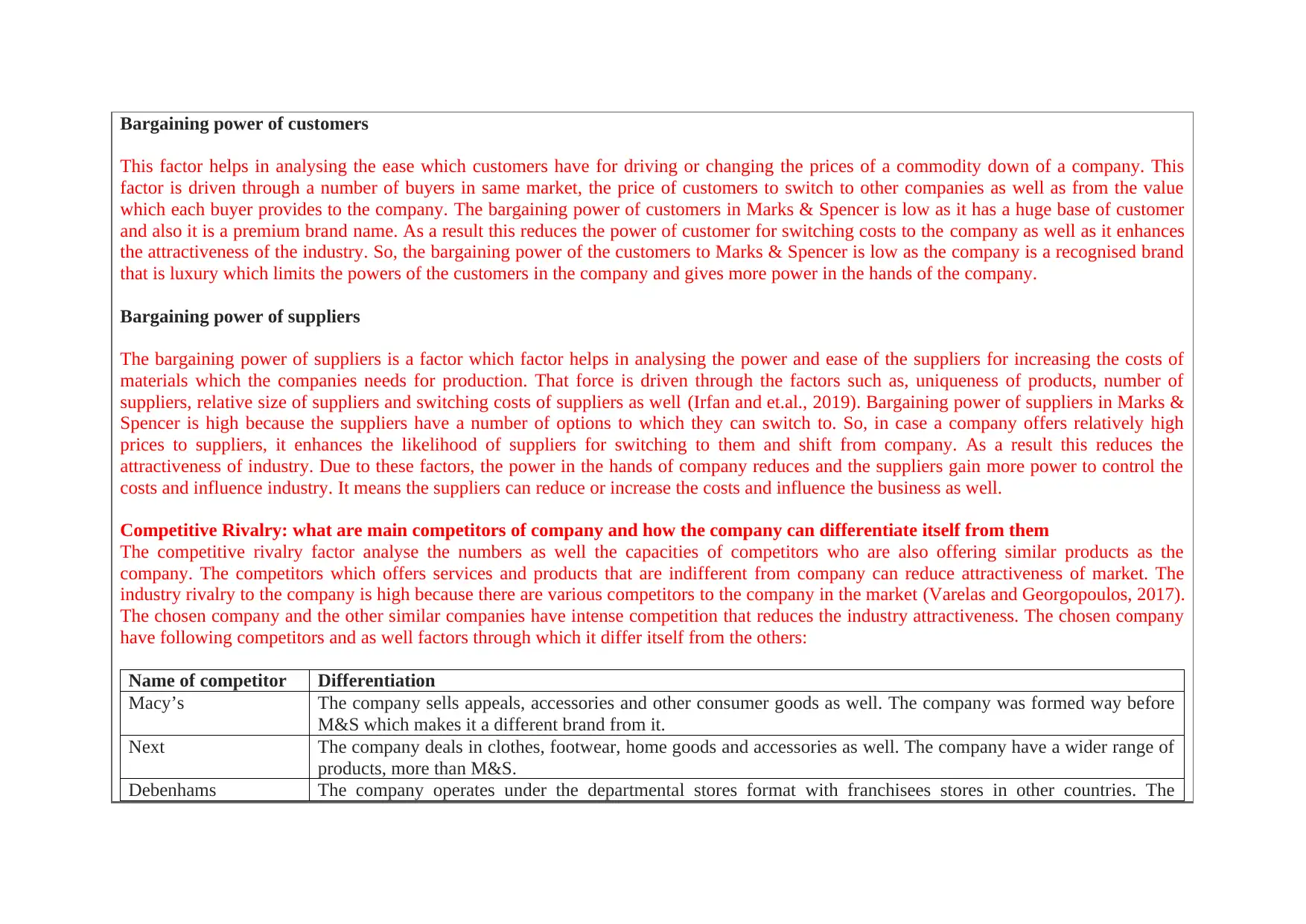
Bargaining power of customers
This factor helps in analysing the ease which customers have for driving or changing the prices of a commodity down of a company. This
factor is driven through a number of buyers in same market, the price of customers to switch to other companies as well as from the value
which each buyer provides to the company. The bargaining power of customers in Marks & Spencer is low as it has a huge base of customer
and also it is a premium brand name. As a result this reduces the power of customer for switching costs to the company as well as it enhances
the attractiveness of the industry. So, the bargaining power of the customers to Marks & Spencer is low as the company is a recognised brand
that is luxury which limits the powers of the customers in the company and gives more power in the hands of the company.
Bargaining power of suppliers
The bargaining power of suppliers is a factor which factor helps in analysing the power and ease of the suppliers for increasing the costs of
materials which the companies needs for production. That force is driven through the factors such as, uniqueness of products, number of
suppliers, relative size of suppliers and switching costs of suppliers as well (Irfan and et.al., 2019). Bargaining power of suppliers in Marks &
Spencer is high because the suppliers have a number of options to which they can switch to. So, in case a company offers relatively high
prices to suppliers, it enhances the likelihood of suppliers for switching to them and shift from company. As a result this reduces the
attractiveness of industry. Due to these factors, the power in the hands of company reduces and the suppliers gain more power to control the
costs and influence industry. It means the suppliers can reduce or increase the costs and influence the business as well.
Competitive Rivalry: what are main competitors of company and how the company can differentiate itself from them
The competitive rivalry factor analyse the numbers as well the capacities of competitors who are also offering similar products as the
company. The competitors which offers services and products that are indifferent from company can reduce attractiveness of market. The
industry rivalry to the company is high because there are various competitors to the company in the market (Varelas and Georgopoulos, 2017).
The chosen company and the other similar companies have intense competition that reduces the industry attractiveness. The chosen company
have following competitors and as well factors through which it differ itself from the others:
Name of competitor Differentiation
Macy’s The company sells appeals, accessories and other consumer goods as well. The company was formed way before
M&S which makes it a different brand from it.
Next The company deals in clothes, footwear, home goods and accessories as well. The company have a wider range of
products, more than M&S.
Debenhams The company operates under the departmental stores format with franchisees stores in other countries. The
This factor helps in analysing the ease which customers have for driving or changing the prices of a commodity down of a company. This
factor is driven through a number of buyers in same market, the price of customers to switch to other companies as well as from the value
which each buyer provides to the company. The bargaining power of customers in Marks & Spencer is low as it has a huge base of customer
and also it is a premium brand name. As a result this reduces the power of customer for switching costs to the company as well as it enhances
the attractiveness of the industry. So, the bargaining power of the customers to Marks & Spencer is low as the company is a recognised brand
that is luxury which limits the powers of the customers in the company and gives more power in the hands of the company.
Bargaining power of suppliers
The bargaining power of suppliers is a factor which factor helps in analysing the power and ease of the suppliers for increasing the costs of
materials which the companies needs for production. That force is driven through the factors such as, uniqueness of products, number of
suppliers, relative size of suppliers and switching costs of suppliers as well (Irfan and et.al., 2019). Bargaining power of suppliers in Marks &
Spencer is high because the suppliers have a number of options to which they can switch to. So, in case a company offers relatively high
prices to suppliers, it enhances the likelihood of suppliers for switching to them and shift from company. As a result this reduces the
attractiveness of industry. Due to these factors, the power in the hands of company reduces and the suppliers gain more power to control the
costs and influence industry. It means the suppliers can reduce or increase the costs and influence the business as well.
Competitive Rivalry: what are main competitors of company and how the company can differentiate itself from them
The competitive rivalry factor analyse the numbers as well the capacities of competitors who are also offering similar products as the
company. The competitors which offers services and products that are indifferent from company can reduce attractiveness of market. The
industry rivalry to the company is high because there are various competitors to the company in the market (Varelas and Georgopoulos, 2017).
The chosen company and the other similar companies have intense competition that reduces the industry attractiveness. The chosen company
have following competitors and as well factors through which it differ itself from the others:
Name of competitor Differentiation
Macy’s The company sells appeals, accessories and other consumer goods as well. The company was formed way before
M&S which makes it a different brand from it.
Next The company deals in clothes, footwear, home goods and accessories as well. The company have a wider range of
products, more than M&S.
Debenhams The company operates under the departmental stores format with franchisees stores in other countries. The
⊘ This is a preview!⊘
Do you want full access?
Subscribe today to unlock all pages.

Trusted by 1+ million students worldwide
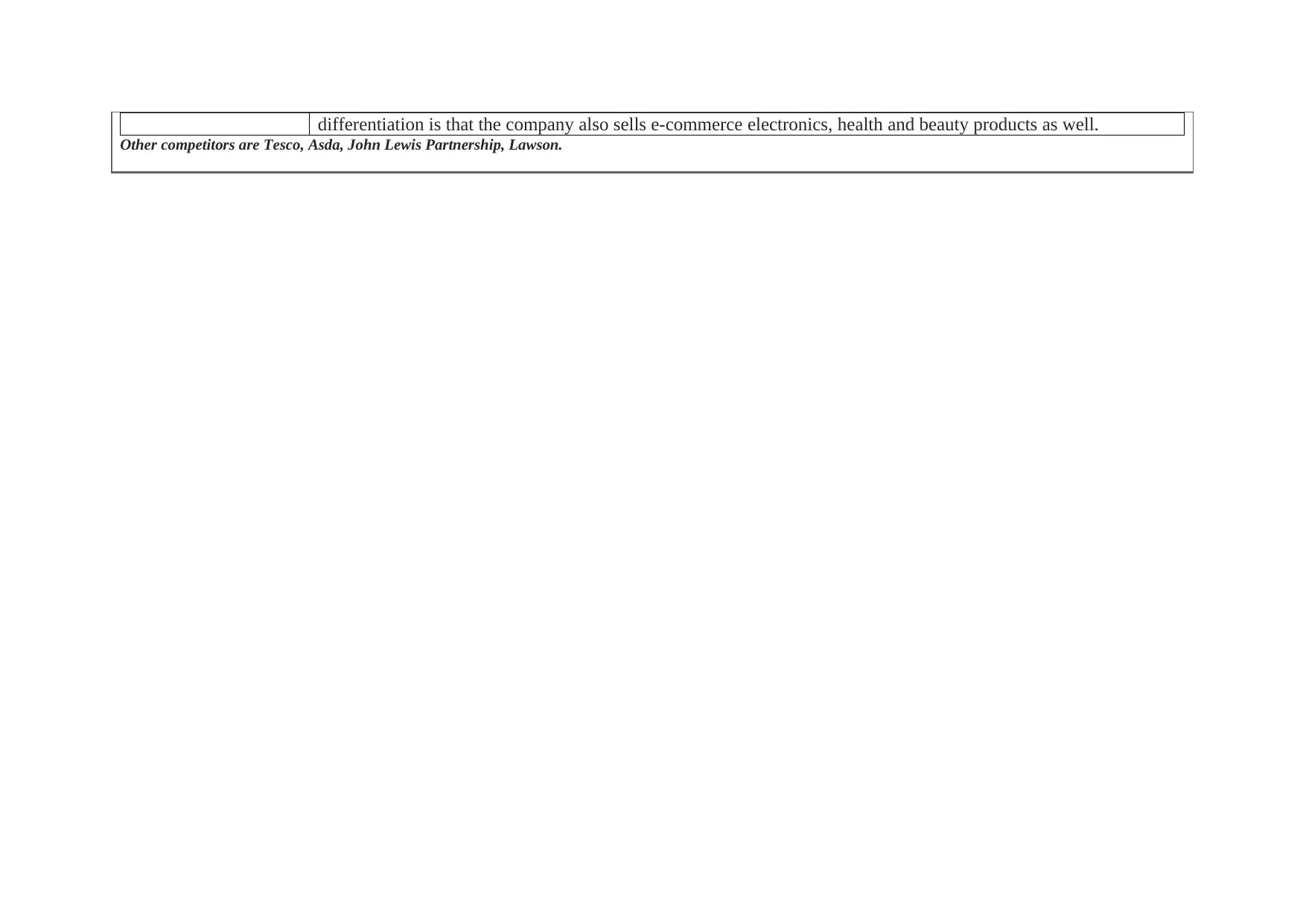
differentiation is that the company also sells e-commerce electronics, health and beauty products as well.
Other competitors are Tesco, Asda, John Lewis Partnership, Lawson.
Other competitors are Tesco, Asda, John Lewis Partnership, Lawson.
Paraphrase This Document
Need a fresh take? Get an instant paraphrase of this document with our AI Paraphraser

OPERATIONS AND MANAGEMENT TEAM
OPERATIONS:
Business process:
Business process refers to the set of tasks or activities which can help the company in attaining its organizational objectives and goals as well.
The business processes involved in the business plan are market research, product development process, sales and marketing, management,
HR and finance as well.
Suppliers and Equipment:
Suppliers are the people who makes the goods, material available to other business in order to produce the desired products or services. The
suppliers of the business plan will be farmers from which raw materials such as fresh plants and food will be collected.
They will be transported to the business site though various transportation such as trucks.
The products will be sold through direct sales and online marketing as well.
The revenue will be generated through sales.
MANAGEMENT TEAM
Name Skills What do they bring to the firm
Manager Strong communication skills, presentation
skills, management and leadership skills,
analytical skills
Managers help the company to attain its
objectives and directs the employees towards
these goals
Sales manager Communication skills, bargaining skills,
developing budgets
They help the company in developing budget
for the business plans and manages
employees who are in sales department.
Marketing manager Creativity and writing skills, numerical
skills, commercial awareness and
organisation and planning skills.
They help the company to create marketing
for the product through which the product
can be made aware and promoted among
audience.
OPERATIONS:
Business process:
Business process refers to the set of tasks or activities which can help the company in attaining its organizational objectives and goals as well.
The business processes involved in the business plan are market research, product development process, sales and marketing, management,
HR and finance as well.
Suppliers and Equipment:
Suppliers are the people who makes the goods, material available to other business in order to produce the desired products or services. The
suppliers of the business plan will be farmers from which raw materials such as fresh plants and food will be collected.
They will be transported to the business site though various transportation such as trucks.
The products will be sold through direct sales and online marketing as well.
The revenue will be generated through sales.
MANAGEMENT TEAM
Name Skills What do they bring to the firm
Manager Strong communication skills, presentation
skills, management and leadership skills,
analytical skills
Managers help the company to attain its
objectives and directs the employees towards
these goals
Sales manager Communication skills, bargaining skills,
developing budgets
They help the company in developing budget
for the business plans and manages
employees who are in sales department.
Marketing manager Creativity and writing skills, numerical
skills, commercial awareness and
organisation and planning skills.
They help the company to create marketing
for the product through which the product
can be made aware and promoted among
audience.
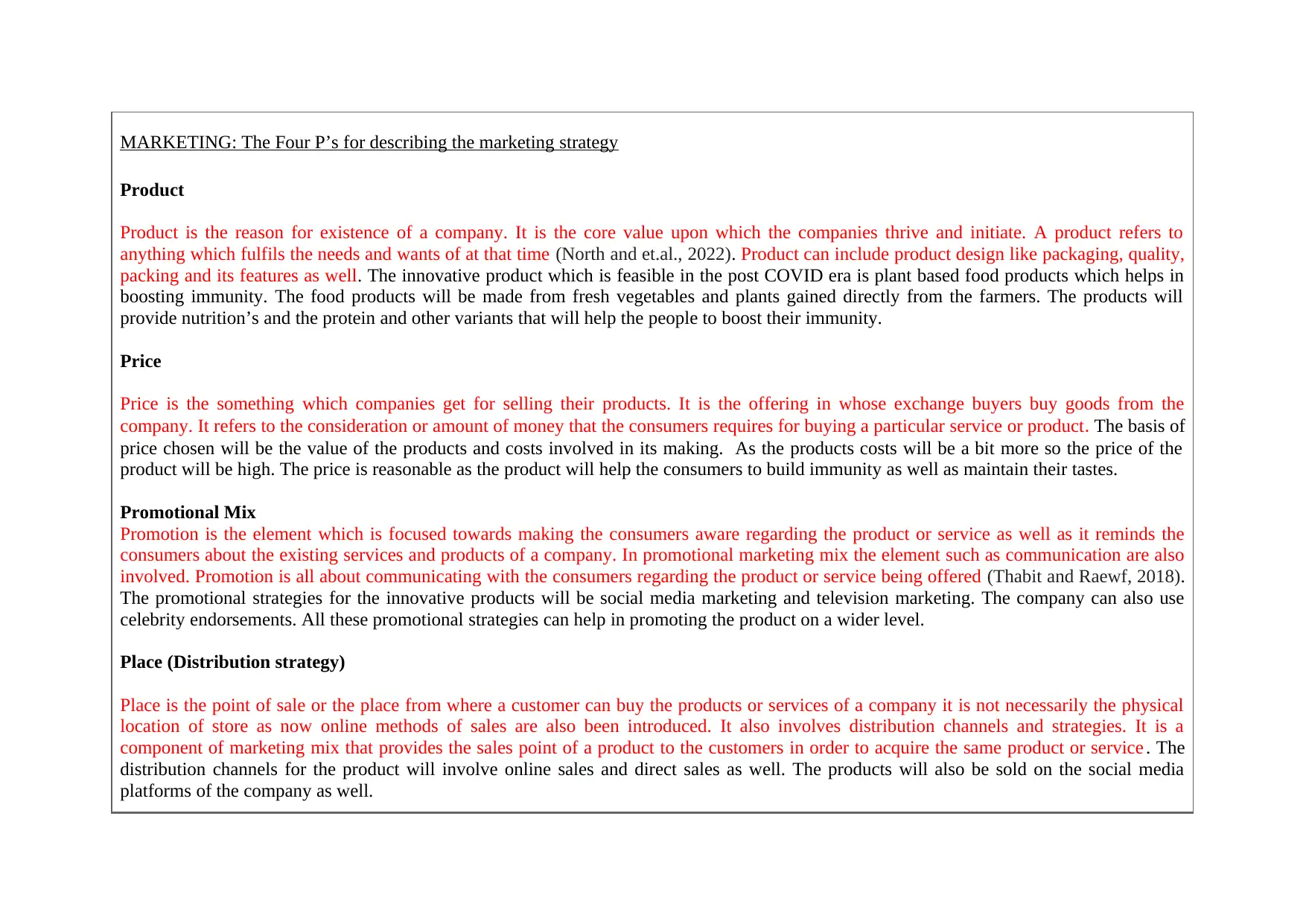
MARKETING: The Four P’s for describing the marketing strategy
Product
Product is the reason for existence of a company. It is the core value upon which the companies thrive and initiate. A product refers to
anything which fulfils the needs and wants of at that time (North and et.al., 2022). Product can include product design like packaging, quality,
packing and its features as well. The innovative product which is feasible in the post COVID era is plant based food products which helps in
boosting immunity. The food products will be made from fresh vegetables and plants gained directly from the farmers. The products will
provide nutrition’s and the protein and other variants that will help the people to boost their immunity.
Price
Price is the something which companies get for selling their products. It is the offering in whose exchange buyers buy goods from the
company. It refers to the consideration or amount of money that the consumers requires for buying a particular service or product. The basis of
price chosen will be the value of the products and costs involved in its making. As the products costs will be a bit more so the price of the
product will be high. The price is reasonable as the product will help the consumers to build immunity as well as maintain their tastes.
Promotional Mix
Promotion is the element which is focused towards making the consumers aware regarding the product or service as well as it reminds the
consumers about the existing services and products of a company. In promotional marketing mix the element such as communication are also
involved. Promotion is all about communicating with the consumers regarding the product or service being offered (Thabit and Raewf, 2018).
The promotional strategies for the innovative products will be social media marketing and television marketing. The company can also use
celebrity endorsements. All these promotional strategies can help in promoting the product on a wider level.
Place (Distribution strategy)
Place is the point of sale or the place from where a customer can buy the products or services of a company it is not necessarily the physical
location of store as now online methods of sales are also been introduced. It also involves distribution channels and strategies. It is a
component of marketing mix that provides the sales point of a product to the customers in order to acquire the same product or service . The
distribution channels for the product will involve online sales and direct sales as well. The products will also be sold on the social media
platforms of the company as well.
Product
Product is the reason for existence of a company. It is the core value upon which the companies thrive and initiate. A product refers to
anything which fulfils the needs and wants of at that time (North and et.al., 2022). Product can include product design like packaging, quality,
packing and its features as well. The innovative product which is feasible in the post COVID era is plant based food products which helps in
boosting immunity. The food products will be made from fresh vegetables and plants gained directly from the farmers. The products will
provide nutrition’s and the protein and other variants that will help the people to boost their immunity.
Price
Price is the something which companies get for selling their products. It is the offering in whose exchange buyers buy goods from the
company. It refers to the consideration or amount of money that the consumers requires for buying a particular service or product. The basis of
price chosen will be the value of the products and costs involved in its making. As the products costs will be a bit more so the price of the
product will be high. The price is reasonable as the product will help the consumers to build immunity as well as maintain their tastes.
Promotional Mix
Promotion is the element which is focused towards making the consumers aware regarding the product or service as well as it reminds the
consumers about the existing services and products of a company. In promotional marketing mix the element such as communication are also
involved. Promotion is all about communicating with the consumers regarding the product or service being offered (Thabit and Raewf, 2018).
The promotional strategies for the innovative products will be social media marketing and television marketing. The company can also use
celebrity endorsements. All these promotional strategies can help in promoting the product on a wider level.
Place (Distribution strategy)
Place is the point of sale or the place from where a customer can buy the products or services of a company it is not necessarily the physical
location of store as now online methods of sales are also been introduced. It also involves distribution channels and strategies. It is a
component of marketing mix that provides the sales point of a product to the customers in order to acquire the same product or service . The
distribution channels for the product will involve online sales and direct sales as well. The products will also be sold on the social media
platforms of the company as well.
⊘ This is a preview!⊘
Do you want full access?
Subscribe today to unlock all pages.

Trusted by 1+ million students worldwide

Paraphrase This Document
Need a fresh take? Get an instant paraphrase of this document with our AI Paraphraser
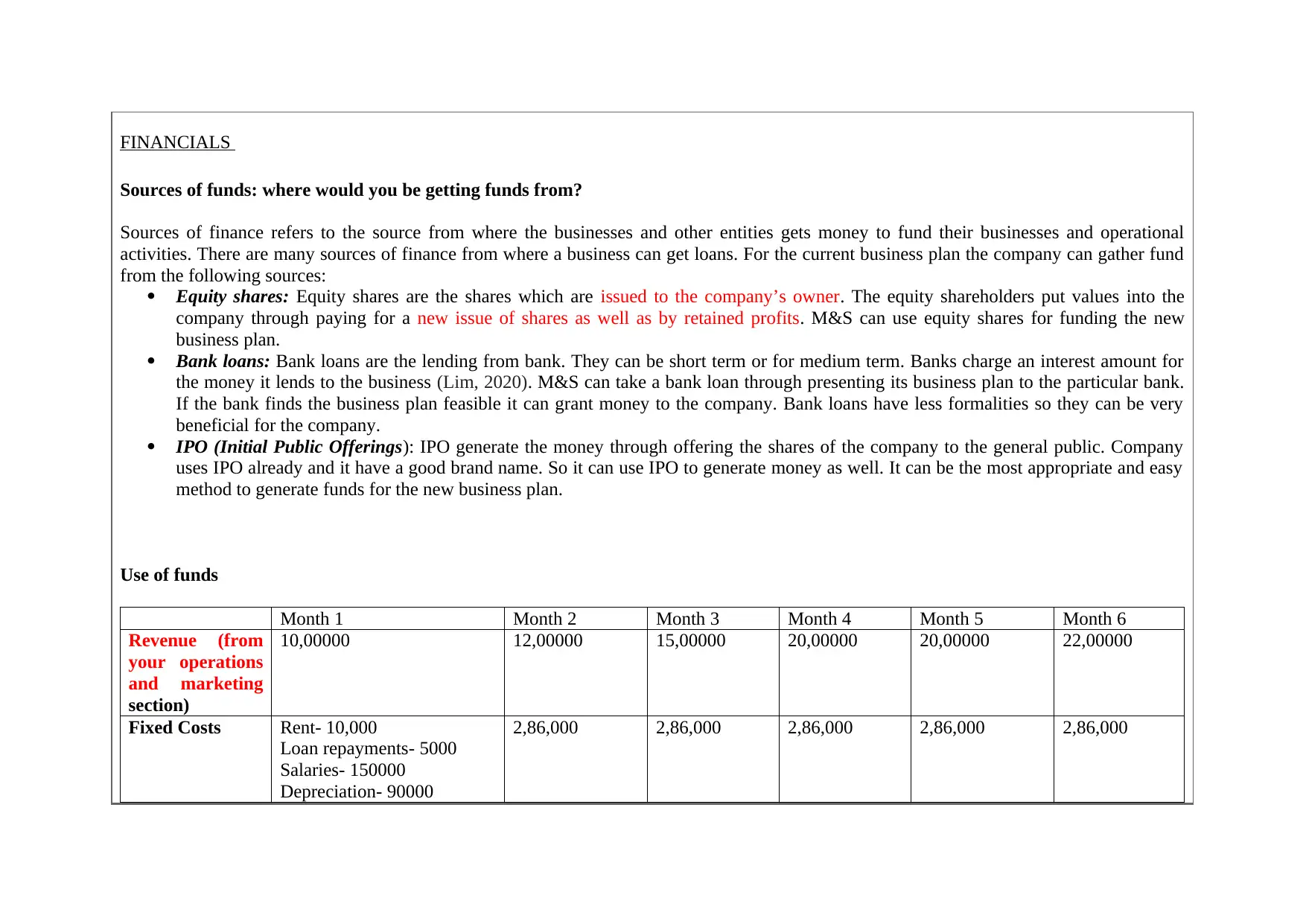
FINANCIALS
Sources of funds: where would you be getting funds from?
Sources of finance refers to the source from where the businesses and other entities gets money to fund their businesses and operational
activities. There are many sources of finance from where a business can get loans. For the current business plan the company can gather fund
from the following sources:
Equity shares: Equity shares are the shares which are issued to the company’s owner. The equity shareholders put values into the
company through paying for a new issue of shares as well as by retained profits. M&S can use equity shares for funding the new
business plan.
Bank loans: Bank loans are the lending from bank. They can be short term or for medium term. Banks charge an interest amount for
the money it lends to the business (Lim, 2020). M&S can take a bank loan through presenting its business plan to the particular bank.
If the bank finds the business plan feasible it can grant money to the company. Bank loans have less formalities so they can be very
beneficial for the company.
IPO (Initial Public Offerings): IPO generate the money through offering the shares of the company to the general public. Company
uses IPO already and it have a good brand name. So it can use IPO to generate money as well. It can be the most appropriate and easy
method to generate funds for the new business plan.
Use of funds
Month 1 Month 2 Month 3 Month 4 Month 5 Month 6
Revenue (from
your operations
and marketing
section)
10,00000 12,00000 15,00000 20,00000 20,00000 22,00000
Fixed Costs Rent- 10,000
Loan repayments- 5000
Salaries- 150000
Depreciation- 90000
2,86,000 2,86,000 2,86,000 2,86,000 2,86,000
Sources of funds: where would you be getting funds from?
Sources of finance refers to the source from where the businesses and other entities gets money to fund their businesses and operational
activities. There are many sources of finance from where a business can get loans. For the current business plan the company can gather fund
from the following sources:
Equity shares: Equity shares are the shares which are issued to the company’s owner. The equity shareholders put values into the
company through paying for a new issue of shares as well as by retained profits. M&S can use equity shares for funding the new
business plan.
Bank loans: Bank loans are the lending from bank. They can be short term or for medium term. Banks charge an interest amount for
the money it lends to the business (Lim, 2020). M&S can take a bank loan through presenting its business plan to the particular bank.
If the bank finds the business plan feasible it can grant money to the company. Bank loans have less formalities so they can be very
beneficial for the company.
IPO (Initial Public Offerings): IPO generate the money through offering the shares of the company to the general public. Company
uses IPO already and it have a good brand name. So it can use IPO to generate money as well. It can be the most appropriate and easy
method to generate funds for the new business plan.
Use of funds
Month 1 Month 2 Month 3 Month 4 Month 5 Month 6
Revenue (from
your operations
and marketing
section)
10,00000 12,00000 15,00000 20,00000 20,00000 22,00000
Fixed Costs Rent- 10,000
Loan repayments- 5000
Salaries- 150000
Depreciation- 90000
2,86,000 2,86,000 2,86,000 2,86,000 2,86,000
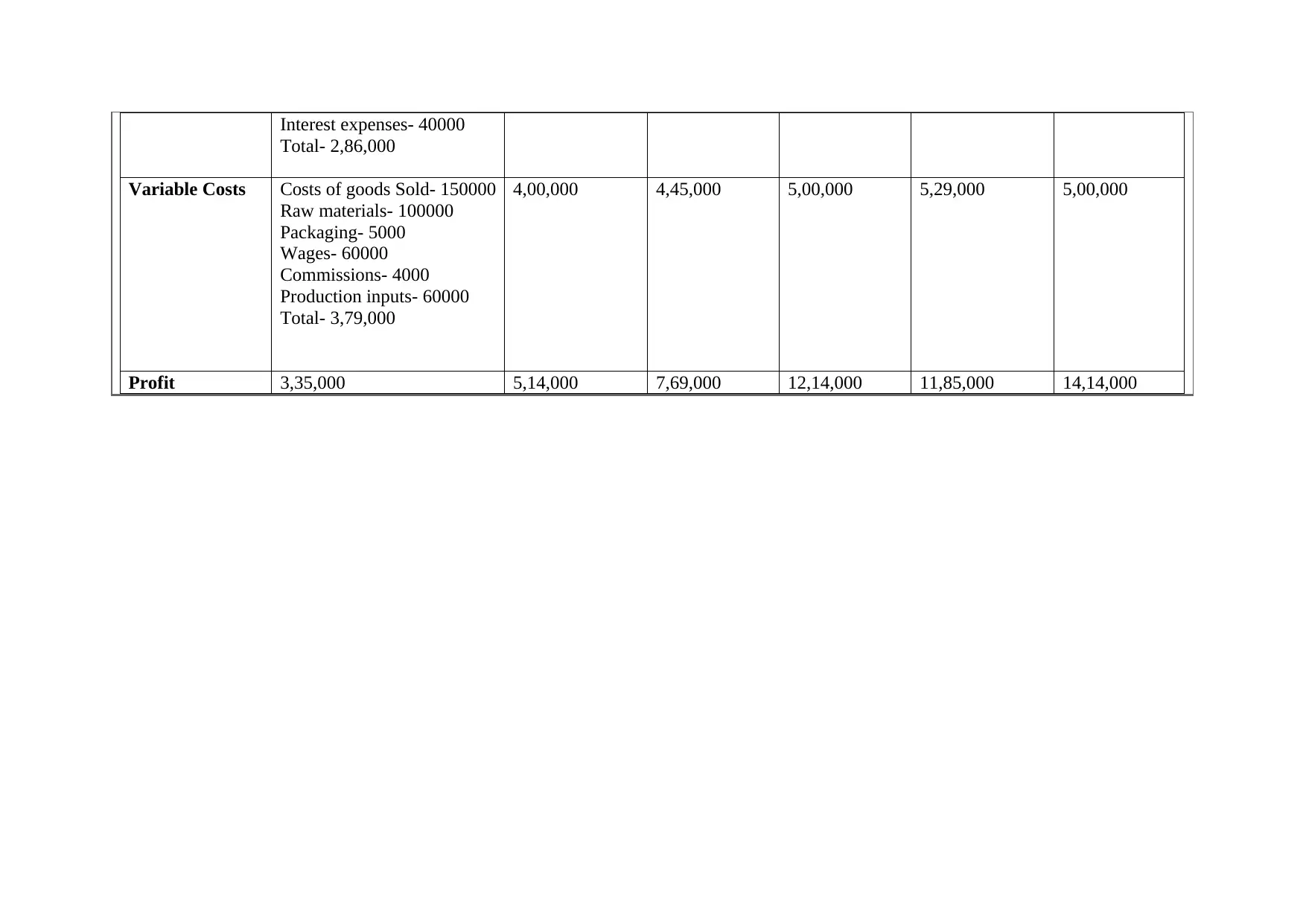
Interest expenses- 40000
Total- 2,86,000
Variable Costs Costs of goods Sold- 150000
Raw materials- 100000
Packaging- 5000
Wages- 60000
Commissions- 4000
Production inputs- 60000
Total- 3,79,000
4,00,000 4,45,000 5,00,000 5,29,000 5,00,000
Profit 3,35,000 5,14,000 7,69,000 12,14,000 11,85,000 14,14,000
Total- 2,86,000
Variable Costs Costs of goods Sold- 150000
Raw materials- 100000
Packaging- 5000
Wages- 60000
Commissions- 4000
Production inputs- 60000
Total- 3,79,000
4,00,000 4,45,000 5,00,000 5,29,000 5,00,000
Profit 3,35,000 5,14,000 7,69,000 12,14,000 11,85,000 14,14,000
⊘ This is a preview!⊘
Do you want full access?
Subscribe today to unlock all pages.

Trusted by 1+ million students worldwide
1 out of 13
Related Documents
Your All-in-One AI-Powered Toolkit for Academic Success.
+13062052269
info@desklib.com
Available 24*7 on WhatsApp / Email
![[object Object]](/_next/static/media/star-bottom.7253800d.svg)
Unlock your academic potential
Copyright © 2020–2025 A2Z Services. All Rights Reserved. Developed and managed by ZUCOL.





